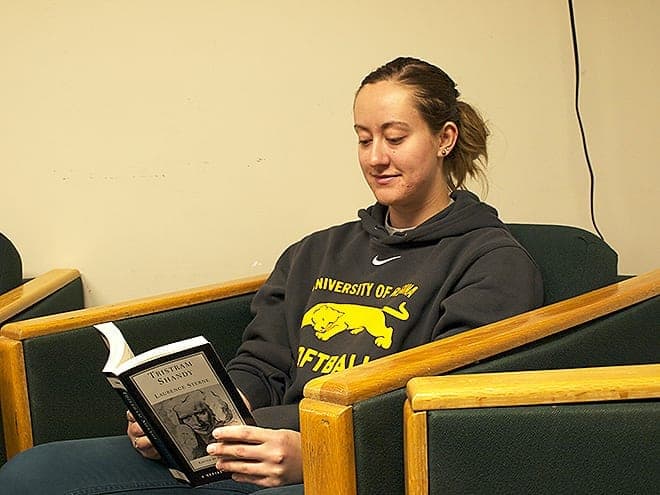Artists and athletes: the bickering siblings

Momma, don’t let your sons grow up to be runners or readers
The construction of the new Mosaic Stadium has, once again, ignited debate as to whether the expense is worth it. Chief among the frustrated are the artists of the world. Those millions that might as well be buried under the turf, they say, would be better spent on art supplies, musical instruments, or anything other than another pair of cleats destined for CFL sod.
Those who support the athletic community, the weight-toting, 40-yard dash running, hoops-shooting obsessives in our midst, have their own story. That sports teams are a catalyst for infrastructure, that the new stadium can revitalize the north central neighbourhood, that merchandise sales and the acclaim that comes with being the greatest show on Sasky turf is worth the sacrifice. The work of these artists, they say, will be pretty things to line the walls with and nothing more.
Both are wrong. Speaking as an athlete and a writer/performer/whatever my loving director calls me next, I find the funding argument incredibly frustrating. At its root is a deep well of professional insecurity and jealousy.
When money has to come from somewhere, when taxpayers (rightfully) resist cuts in education or health-related spending, where do they turn? Well, they look toward the dance studios and basketball gyms. Sports and art are just fun things to engage with. I mean yes, by all means stay healthy, but a new MRI machine is more important than a fancy tennis court or a brand new arts venue, Right? Wrong again.
And here’s where each of these communities falter: because they are both the enemies of the public imagination – I can almost hear the cries of “No more free tickets!” from here – these two presumed rivals turn against each other. Cleats squaring off against ballet shoes in an epic war of footwear, helmets sparring with costume pieces, basketball hoops versus balconies.
Both sports and the creative arts have something incredibly tangible to gift to the community. Calling one another useless, frivolous, petty, only deepens the distrust that the public holds. If the arts are always striking out, or the professional teams of the world are always asking for more money at the expense of the other, why should either be believed? The Roughriders are part of the cultural imagination in this province, like it or not, so let’s embrace it, for example.
There is a theatre show, Rider Girl, which partially concerns itself with the sporting world. This mutual support should happen, and it does. Half time shows provide an excellent opportunity for arts organizations to display their talents, and I’m not just talking about the cheerleading team. The Rider drum line is an artistic endeavor, as are any of the musical acts that are asked to perform the national anthem. This may seem like a small thing, but such crossover is vital. Is anyone going to the theatre just to see the Riders get mentioned? Probably not. Are diehard Rider fans flooding into Mosaic Stadium to hear a young singer belt out the national anthem? Same answer applies, but that doesn’t mean their contribution, no, their inclusion, is any less valuable.
Arguments over funding get ugly, but this shouldn’t be a case of one over the other. I hate to break it to you, but you can support both. Go ahead, be skeptical over the stadium’s influence on the neighbourhood surrounding it. If you don’t like abstract or performance art, don’t attend. Also, just because you’re a fan of the arts doesn’t mean you have to agree with everything in the artistic community. There are instances of bad art, there are terrible football teams. You do not have to like sports in order to support the stadium, just as you can be distant the arts personally and still champion their continued funding.
Ever notice how in sports media, athletes are often compared to artists? Talk of the person’s craft, dedication, and artsy descriptions of their various movements abound. Similarly, many artistic pursuits require amazing amounts of athleticism. There are the obvious examples (dance being the most notable) but acting can be equally as taxing, requiring of the performer the ability to execute delicate and precise movements with the consistency of a computer program.
And forget talk of money, thing of all the advantages these two avenues provide. Sports, with its focus on leadership, coordination, physical training, dedication, team building, and work ethic. With the arts, it’s leadership, creativity, coordination, dedication and, wait for it, team building. Just like those advertisements that show just how few collegiate athletes become professionals, most children who grow up experiencing art on a regular basis do not become pro artists themselves. This does not lessen the experiences for either individual. If you grow up playing sports, you will (likely) spend the rest of your life with some form of appreciating or at least understanding of the sporting world. Just like, if your parent or guardian chucks you into every artistic program imaginable, you are likely to have a connection with creativity long into your adulthood.
Neither are considered stable careers, which is why so many openly show their criticism, and with a guilty verdict in the court of public opinion comes a lessening of cultural importance. So, in the end, the artists and the athletes are fighting it out four the same ever-dwindling pot of gold and, in doing so, are only decreasing each other’s chances at making the big-time. After all, a life without sport or art is a life not worth living, I think it’s fair to say.
Without arts funding, there is no music, no dance, no theatre. Without sports funding, there are no after school programs, no local hockey teams, no intramural sports. Bickering just leads to losing where it hurts: in our pocketbooks and in our culture.










